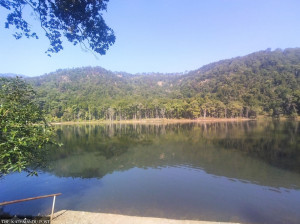Sudurpaschim Province
Grassland management begins in Suklaphanta National Park
The park is conducting controlled bonfires in different parts of the grassland to manage wildlife.
Bhawani Bhatta
The grassland of Suklaphanta National Park is the main habitat of swamp deer. The park’s 54.5 square kilometres grassland is one of the largest grasslands in South Asia.
The park authorities manage the grassland to sustain swamp deer population and other wildlife. This season, the park is conducting controlled bonfires in different parts of the grassland to manage wildlife.
“The grassland has to be managed to create a proper shelter and feeding and ambushing environment for wild animals. Wild animals shift from one location to another when controlled bonfires take place in the grassland,” said Rabin Chaudhary, the assistant conservation officer of the park.
According to park officials, grassland management works are usually carried out during the winter season.
“Tractors are used to cut old grasses. Employees at the park conduct a controlled bonfire after grass, leaves and branches of bushes dry up. In some parts of the grassland, bushes are left to grow for wild creatures like tigers and leopards,” said Chaudhary. “The main objective of managing grassland is to protect the habitat of wild animals.”
Established as a national park in 1976, Shuklaphanta is the country’s second youngest national park, after Parsa National Park, and is the main habitat of swamp deer. The largest herd of swamp deer in Asia can be seen in the grasslands of Shuklaphanta, according to conservationists.
If there were enough big animals in the park, the grassland would be maintained naturally, say park authorities. But given the dwindling number of big animals in the park, park authorities have to adopt artificial measures like using machines to cut grass.
“There aren’t enough big animals to keep the natural progression of the park’s upkeep going,” said Chaudhary.
According to Chaudhary, the Department of National Parks and Wildlife Conservation has allocated Rs 6 million budget to manage the grassland in Shuklaphanta National Park. The grassland in Andaiya Pataiya will also be managed this year along with the grassland in Shuklaphanta, he informed. Andaiya Pataiya grassland is spread across 13 square kilometres of land and is also a major pasture land for swamp deer.
“The new sprout is the major food of the deer species. It is very nutritious and easily digestible,” said Laxmi Joshi, chief of the Shuklaphanta Conservation Programme of National Trust for Nature Conservation. “The animal detest mature grass. That’s why we have to cut the overgrown grass and burn or leave them unused.”
Joshi says that swamp deer would face a shortage of food if the grasses were overgrown. According to him, though some birds and animals are affected while disposing of overgrown grasses, it has a larger positive impact. Before cutting the grass and burning them, fire lines are made so that the fire won’t spread to other areas.
Even the grasses outside the grassland are cut and burnt sometimes—mainly during the rhino census. “The grasses are cut and burnt so that rhinos are easily seen from a distance,” said Chaudhary.
Jungle safaris are open in the Shuklaphanta National Park from mid-September to mid-June each year. The safari, which was closed in March due to Covid-19 restrictions, came to operation from October this year. According to Chaudhary, a total of 1,837 people have visited the national park since the resumption of safari services.




 17.12°C Kathmandu
17.12°C Kathmandu











%20(1).jpg&w=300&height=200)

